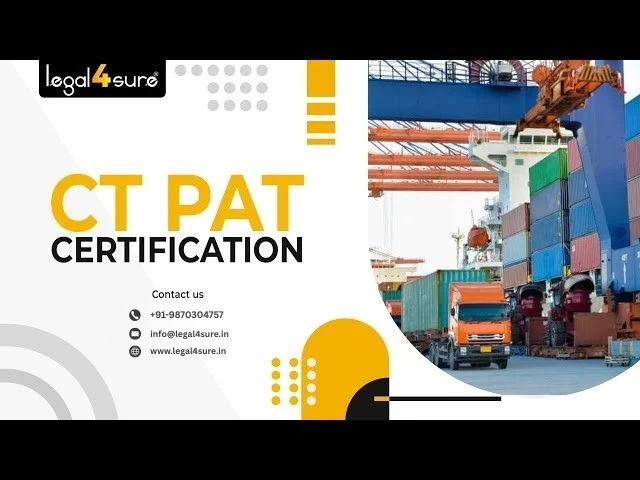CTPAT: Benefits & Certification Process
Customs delays don't just hold up shipments; they impact the entire business. Deadlines are missed, costs increase, and worst of all, buyers start questioning your credibility. The point is clear: this is the problem CTPAT certification is designed to solve. It proves that your supply chain is secure, gives you faster border clearance, and strengthens your credibility with customers. Now let's understand what its real benefits are and the steps to achieve them.
Why Companies Rely on CTPAT Certification
Trade is built on trust. Customs officials need assurance that shipments are safe, and buyers want suppliers to be reliable. This is where CTPAT certification comes in. It puts you in the trusted category and shows that you take security seriously.
Let’s put it simply:
- Less scrutiny – Certified shipments are considered less risky.
- Faster clearance – Goods don’t wait long at customs.
- Buyers trust – Importers prefer suppliers who invest in security.
- Competitive edge – Certification sets you apart from competitors without certification.
- Official recognition – You are listed as a trusted partner by US Customs and Border Protection.
Basically, it’s not just about following the rules. It really means that you are recognized as a trusted player in the global supply chain.
Real Benefits Businesses See After Certification
Many companies shy away from the program because they think it’s all about rules and formalities. The truth is that CTPAT certification offers benefits that make day-to-day operations easier and faster.
- Saving time means saving money – When delays are reduced, deliveries are faster and warehousing costs are reduced.
- Stronger buyer relationships – Many multinational buyers expect or require this certification.
- Reduced supply chain risk – From preventing tampering to reducing theft, better security keeps goods safe.
- Business continuity – Certified companies have systems in place that help speed up recovery after an outage.
- Ease of auditing – This certification often pre-empts questions on a buyer’s compliance checklist.
The simple fact is that CTPAT certification should be considered an investment, not an expense. It takes effort to implement, but the benefits are long-term in the form of trust, efficiency, and new opportunities for business growth.
How the CTPAT certification process unfolds
Certification may seem intimidating from the outside, but it is actually a straightforward journey if you prepare step by step.
Let's understand it step by step.
Application
Submit an online application on the CTPAT portal using company data and supply chain information.
Security Profile
This step is detailed. You will have to explain your security practices in every area, such as entry control, information technology systems, supplier inspections, goods handling procedures, and employee training.
Document Review
The CTPAT team will check your profile against their security standards. If any information is found incomplete or weak, you will be asked to correct it and upload it.
Verification Inspection
An officer from the US Customs and Border Protection will visit your site to ensure that your actual practices are in line with the documents.
Certification Acceptance
If the verification is successful, your company officially receives the CTPAT certification, and you are recognized as a trusted partner.
The process is structured. With the right planning and necessary improvements, this can easily be accomplished.
How to prepare for a smooth certification journey
The difference between an easy approval and a stressful one is largely a matter of preparation. Now let’s see what helps.
Train employees – From the gate guards to the IT system staff, everyone should understand that maintaining security is their responsibility.
Keep records organized – Access logs, supplier verification, and visitor records should always be up to date and easily accessible.
Conduct internal audits – Before the official validation, conduct your own audit. If you catch and correct the flaws early, there will be no problems later.
Involve suppliers – If there is a weak link in your vendor network, the entire process can come to a halt. It is better to keep your partners compliant with security standards as well.
Take expert help if needed – Consultants experienced in CTPAT certification can guide you and make the process faster and clearer.
Preparation not only speeds up the process but also instills habits that will keep your supply chain secure even after an audit.
Why certification is worth the effort
Some companies are put off by the process. But the truth is that without certification, you face longer inspections, limited buyer options, and higher risks. But having this certification sends a clear message to the world that you take trade security seriously.
Customs is not going to get easier, and buyer expectations are not going to get any lower. Only those companies will move ahead who can demonstrate trust not just by words, but by concrete actions. And CTPAT certification does just that.
Securing the Supply Chain with CTPAT Certification
In international trade, trust and reliability are key to long-term success. Companies that position themselves as dependable supply chain partners gain significant advantages such as quicker customs clearances, reduced risks, and higher confidence among global buyers.
The Customs Trade Partnership Against Terrorism (CTPAT) certification plays an important role in achieving this. It establishes that a company follows strict security practices across its operations, ensuring safety and compliance within the supply chain. Organizations that delay or overlook compliance often face disruptions, while those with structured systems are better prepared to meet global standards.
By aligning with CTPAT requirements, businesses can safeguard consignments, strengthen consumer trust, and create opportunities for sustainable growth in export markets .


